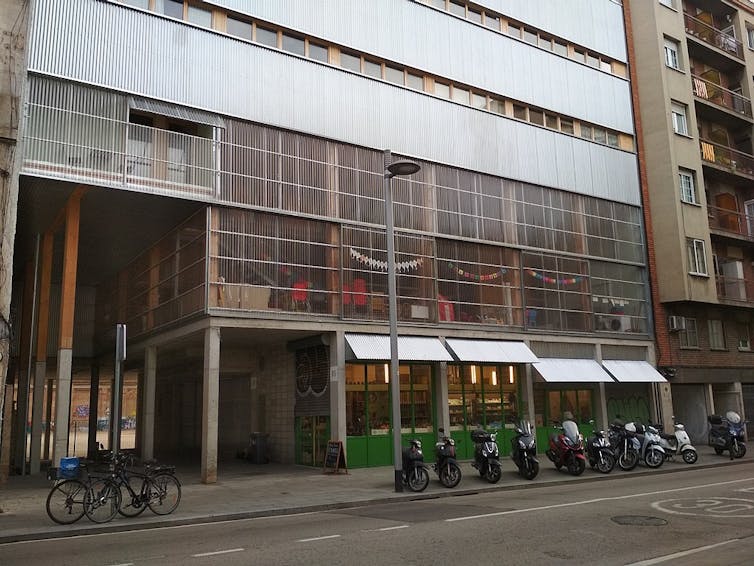Johannes Novy– Senior Lecturer in Urban Planning, School of Architecture and Cities, University of Westminster

The debate around how to fix the global housing crisis usually hinges on whether more market or more state is required. Some people stress the need for additional housing stock and less regulatory red tape, so that the market can create it. Others claim that stricter government measures – against ruthless developers and landlords, more rent control, and more public housing – are crucial.
Increasingly, policymakers are paying attention to what lies between the public and private sectors. The United Nations’ New Urban Agenda – a key international policy framework to promote sustainable urban development – highlights the benefits of “cooperative solutions, such as cohousing, community land trusts and other forms of collective tenure”. A slew of recent community-led housing projects across Europe and beyond show how this can work.
Cohousing includes all kings of edifices, new and existing. It is not tied to a particular type of tenure. And the groups of people it involves can vary considerably in size. At its heart are two key principles. Residents do not only live next to each other, but with each other, in buildings that comprise communal spaces and facilities. And they take the lead, or at least are involved in, the design and management of their communities.
Communal life
German sociologist Anja Szypulski has lauded the “abundant potential” cohousing proffers for sustainable housing and neighbourhood development. The first way it does this is by promoting an ethos of participation and sharing.
Residents are involved throughout the building process. When, in the wake of the 2008 financial crash, a developer pulled out of a state-owned site in Cambridge, the city council opted for a cohousing initiative to build on the land instead, precisely because of the social and community benefits that would bring.
The resulting Marmalade Lane project opened in 2018 after four years, during which the cohousing members developed the architectural brief, sought planning permission and contracted builders.
Residents also often take part in actually building their homes too. The Church Grove project in Lewisham, south London, is a community-led housing development on a old derelict school and industrial site. When completed it will count 36 homes designed to be permanently affordable. To keep the costs low, future residents are involved in this construction process. They have already built a communal hall on the site.
Communality also shapes daily life in a cohousing project. Marmalade Lane residents share 42 homes – houses and flats, both – organised around a common house with a shared kitchen, refectory and fireplace, a pedestrianised lane, outdoor play area and garden, a laundry, a gym and a workshop.
Similarly, La Borda, in Barcelona, is a cooperative housing block comprising 28 apartments, organised around a communal, open-plan atrium. Residents share a kitchen-dining area, a laundry room, guest rooms and generous outdoor spaces. Their flats were deliberately designed small, with movable walls, so that a room belonging to one flat could become part of another, as the need arose.

Socially and architecturally sustainable
The La Borda project contributes to the wider community, too, by organising events and sourcing goods from local cooperatives. It is based on a participatory planning process and costs have been kept low through the use of smart low-tech solutions and a lot of self-help during construction by its future users, who are also responsible for the maintenance and management of the project. Decisions are made collectively in a general assembly and all adults participate in various committees that deal with different issues, from financial matters to communal dinners
While the idea of committee meetings and doors facing each other won’t appeal to everyone, the benefits of knowing you’re not alone are clear. Residents at Marmalade Lane have spoken about children playing together, stay-at-home mothers not feeling isolated and retirees being engaged and occupied.
The UK Cohousing network describes cohousing as a “way of resolving the isolation many people experience today, recreating the neighbourly support of the past”. And research bears this out. A recent study on the way cohousing dwellers in the UK coped with lockdown found that many residents experienced a level of mutual support and care that went well beyond the general good neighbourliness of the early days of the pandemic.
Cohousing projects also encourage sustainability by typically being built for the long term. The Marmalade Lane buildings used environmentally-friendly materials and designs that promote low-energy use for a small carbon footprint.

One reply on “Cohousing is empowering people to fight back against a global housing crisis”
Very interesting. I had not read about this before. I wish them success because it would answer a world wide problem.
LikeLiked by 1 person